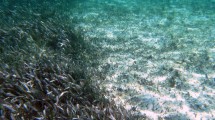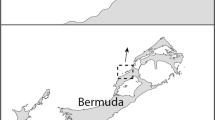Abstract
Four meadows of turtle grass (Thalassia testudinum Banks ex Konig) in Sarasota Bay, Florida were sampled on a bimonthly basis from June 1992 to July 1993 to determine spatial and temporal variation in short shoot density, biomass, productivity, and epiphyte loads. Concurrent with the seagrass sampling, quarterly water-quality monitoring was undertaken at ≥3 sites in the vicinity of each studied seagrass meadow. Three months after termination of the seagrass sampling effort, a biweekly water-quality monitoring program was instituted at two of the seagrass sampling sites. In addition, a nitrogen loading model was calibrated for the various watersheds influencing the seagrass meadows. Substantial spatial and temporal differences in turtle grass parameters but smaller spatial variation in water quality parameters are indicated by data from both the concurrent quarterly monitoring program and the biweekly monitoring program instituted after termination of the seagrass study. Turtle grass biomass and productivity were negatively correlated with watershed nitrogen loads, while water quality parameters did not clearly reflect differences in watershed nutrient inputs. We suggest that traditional water-quality monitoring programs can fail to detect the onset or continuance of nutrient-induced declines in seagrass health. Consequently, seagrass meadows should be monitored directly as a part of any effort to determine status and/or trends in the health of estuarine environments. *** DIRECT SUPPORT *** A01BY074 00029
Similar content being viewed by others
Literature Cited
American Public Health Association. 1989. Standard Methods for the Examination of Water and Wastewater, 17th edition. American Public Health Association, American Water Works Association, Water Pollution Control Federation, Washington, D.C.
Barber, B. J. and P. J. Behrens. 1985. Effects of elevated temperature on seasonal in situ leaf productivity of Thalassia testudinum Banks ex Konig and Syringodium filiforme Kutzing. Aquatic Botany 22:61–69.
Burkholder, J. M., K. M. Mason, and H. B. Glasgow. 1992. Water column nitrate enrichment promotes decline of eelgrass Zostera marina: Evidence from seasonal mesocosm experiments. Marine Ecology Progress Series 81:163–178.
Cambridge, M. L. and A. J. Mccomb. 1984. The loss of seagrass in Cockburn Sound, Western Australia. I. The time course and magnitude of seagrass decline in relation to industrial developments. Aquatic Botany 20:229–243.
Camp, Dresser, and McKee, Inc. 1992. Point/Non-point Source Pollution Loading Assessment. Phase I. Final Report to the Sarasota Bay National Estuary Program, Sarasota, Florida.
Culter, J. 1992. Estuarine bottom assessment, p. 8-1–8-18. In P. Roat, C. Ciccolella, H. Smith, and D. Tomasko (eds.). Sarasota Bay: Framework for Action. Sarasota Bay National Estuary Program, Sarasota, Florida.
Dennison, W. C., R. J. Orth, K. A. Moore, J. C. Stevenson, V. Carter, S. Kollar, P. W. Bergstrom, and R. A. Batuik. 1993. Assessing water quality with submersed aquatic vegetation. Bioscience 43:86–94.
Dixon, L. K. and G. Kirkpatrick. 1995. Light Attenuation with Respect to Seagrasses in Sarasota Bay, Florida. Final Report to the Sarasota Bay National Estuary Program. Sarasota. Florida.
Duke, T. D. and W. L. Kruczynski. 1992. A summary of the report: Status and trends of emergent and submerged vegetated habitats of the Gulf of Mexico, USA, p. 11–28. In The Environmental and Economic Status of the Gulf of Mexico. Gulf of Mexico Program, Stennis, Mississippi.
Fourqurean, J. W., J. C. Zieman, and G. V. N. Powell. 1992a. Phosphorus limitation of primary production in Florida Bay: Evidence from C:N:P ratios of the dominant seagrass Thalassia testudinum. Limnology and Oceanography 37:162–171.
Fourqurean, J. W., J. C. Zieman, and G. V. N. Powell. 1992b. Relationships between porewater nutrients and seagrasses in a subtropical carbonate environment. Marine Biology 114:57–65.
Haddad, K. D. 1989. Habitat trends and fisheries in Tampa and Sarasota Bays, p. 113–128. In E. Estevez (ed.), Tampa and Sarasota Bays: Issues, Resources, Status, and Management. NOAA Estuary-of-the-Month. Seminar Series No. 11. National Oceanic and Atmospheric Administration, Washington, D.C.
Heyl, M. G. 1992. Point and non-point source pollutant loading assessment, p. 12.1–12.9 In P. Roat, C. Ciccolella, H. Smith, and D. Tomasko (eds.), Sarasota Bay: Framework for Action, Sarasota Bay National Estuary Program. Sarasota, Florida.
Iman, R. L. and W. J. Conover. 1983. A Modern approach to Statistics. John Wiley and Sons, New York.
Johansson, J. O. R. 1991. Long-term trends of nitrogen loading, water quality, and biological indicators in Hillsborough Bay, Florida, p. 157–176. In S. F. Treat and P. A. Clark (eds.), Proceedings, Tampa Bay Area Scientific Information Symposium 2. Tampa Bay Regional Planning Council, St. Petersburg, Florida.
Kemp, W. M., W. R. Boynton, R. R. Twilley, J. C. Stevenson, and J. C. Means. 1983. The decline of submerged vascular plants in upper Chesapeake Bay: Summary of results concerning possible causes. Marine Technology Society Journal 17: 78–89.
Lapointe, B. E., D. A. Tomasko, and W. Matzie. 1994. Trophic structuring of marine plant communities in the Florida Keys. Bulletin of Marine Science 54:696–717.
Larkum, A. W. D. 1976. Ecology of Botany Bay. I. Growth of Posidonia australis (Brown) Hook. f. in Botany Bay and other bays of the Sydney Basin. Australian Journal of Marine and Freshwater Research 27:117–127.
Leverone, J. R. and M. J. Marshall. 1992. Seagrass bed faunal utilization study. Final Report to the Sarasota Bay National Estuary Program, Sarasota, Florida.
Lewis, R. R., M. J. Durako, M. D. Moffler, and R. C. Phillips. 1985. Seagrass meadows of Tampa Bay—A review, p. 210–246. In S. F. Treat, J. L. Simon, R. R. Lewis, and R. L. Whitman (eds.), Proceedings, Tampa Bay Area Scientific Information Symposium. Florida Sea Grant Publication 65, Burgess, Minneapolis.
Lowrey, S. S., L. K. Dixon, P. Sherblom, and M. G. Heyl. 1993. Water and Sediment Quality: Trends and Status for Sarasota Bay. Final Report to the Sarasota Bay National Estuary Program. Sarasota, Florida.
Mangrove Systems, Inc. 1988. Marine Habitat Trend Analysis. Special Report to Sarasota County, Florida.
Montgomery, R. T., B. F. Mcpherson, and E. E. Emmons. 1991. Effects of nitrogen and phosphorus additions on phytoplankton productivity and chlorophyll a in a substropical estuary, Charlotte Harbor, Florida. United States Geological Survey, Water Resources Investigations Report 91-4077. Tampa, Florida.
Neverauskas, V. 1987. Accumulation of periphyton biomass on artificial substrates deployed near a sewage sludge outfall in South Australia. Estuarine Coastal and Shelf Science 25:509–517.
Orth, R. J. and K. A. Moore. 1984. Distribution and abundance of submerged aquatic vegetation in Chesapeake Bay: An historical perspective. Estuaries 7:531–540.
Powell, G. V. N., W. J. Kenworthy, and J. W. Fourqurean. 1989. Experimental evidence for nutrient limitation of seagrass growth in a tropical estuary with restricted circulation. Bulletin of Marine Science 44:324–340.
Powell, G. V. N., J. W. Fourqurean, W. J. Kenworthy, and J. C. Zieman. 1991. Bird colonies cause seagrass enrichment in a subtropical estuary: Observational and experimental evidence. Estuarine Coastal and Shelf Science 32:567–579.
Reyes, E. and M. Merino. 1991. Diel dissolved oxygen dynamics and eutrophication in a shallow, well-mixed tropical lagoon (Cancun, Mexico). Estuaries 14:372–381.
Sand-Jensen, K. 1977. Effect of epiphytes on eelgrass photosynthesis. Aquatic Botany 3:55–63.
SAS Institute, Inc. 1985. SAS Procedures Guide. Version 6, third edition. SAS Institute Inc., Cary, North Carolina.
Schefler, W. C. 1979. Statistics for the Biological Sciences. Addison-Wesley Publishing Company, Reading, Massachusetts.
Sheng, Y. P. and S. Peene. 1992. Circulation and its effect on water quality, p. 5.1–5.18. In P. Roat, C. Ciccolella, H. Smith, and D. Tomasko (eds.), Sarasota Bay: Framework for Action. Sarasota Bay National Estuary Program. Sarasota, Florida.
Short, F. T., D. M. Burdick, J. Wolf, and G. E. Jones. 1993. Eelgrass in Estuarine Research Reserves Along the East Coast, U.S.A., Part I: Declines from Pollution and Disease, and Part II: Management of Eelgrass Meadows. National Oceanic and Atmospheric Administration, Coastal Ocean Program. Washington, D.C.
Short, F. T., M. W. Davis, R. A. Gibson, and C. F. Zimmerman. 1985. Evidence for phosphorus limitation in carbonate sediments of the seagrass Syringodium filiforme. Estuarine Coastal and Shelf Science 20:419–430.
Short, F. T., W. C. Dennison, and D. G. Capone. 1990. Phosphorus-limited growth of the tropical seagrass Syringodium filiforme in carbonate sediments. Marine Ecology Progress Series 62: 169–174.
Silberstein, K., A. W. Chiffings, and A. J. Mccomb. 1986. The loss of seagrass in Cockburn Sound, Western Australia. III. The effect of epiphytes on productivity of Posidonia australis Hook. F. Aquatic Botany 24:355–371.
Slawyk, G. and J. J. MacIsaac. 1972. Comparison of two automated ammonium methods in a region of coastal swelling. Deep Sea Research 19:521–524.
Smith, S. V., W. J. Kimmerer, E. A. Laws, R. E. Brock, and T. W. Walsh. 1981. Kaneohe Bay sewage diversion experiment: Perspectives on ecosystem responses to nutritional pertubation. Pacific Science 35:278–396.
Suttle, C. A. and P. J. Harrison. 1988. Ammonium and phosphate uptake kinetics of size-fractionated plankton from an oligotrophic freshwater lake. Journal of Plankton Research 10: 133–149.
Suttle, C. A., J. A. Fuhrman, and D. G. Capone. 1990. Rapid ammonium cycling and concentration-dependent partitioning of ammonium and phosphate: Implications for carbon transfer in plankton communities. Limnology and Oceanography 35:424–433.
Technicon Industrial Systems. 1973. Technicon Autoanalyzer II, Industrial Methods. Technicon Industrial Systems. Tarry-town, New York.
Tomasko, D. A., D. M. Alderson, P. Clark, J. Cultrr, L. K. Dixon, R. Edwards, E. Estevez, M. G. Heyl, S. Lowrey, Y. P. Sheng, and J. Stevely. 1992. Technical synthesis of Sarasota Bay, p. 14.1–14.16. In P. Roat, C. Ciccolella, H. Smith, and D. Tomasko (eds.), Sarasota Bay: Framework for Action. Sarasota Bay National Estuary Program. Sarasota, Florida.
Tomasko, D. A. and C. J. Dawes 1989. Evidence for physiological integration between shaded and unshaded short shoots of Thalassia testudinum. Marine Ecology Progress Series 54:299–305.
Tomasko, D. A. and C. J. Dawes. 1990. Influences of season and water depth on the clonal biology of the seagrass Thalassia testudinum. Marine Biology 105:345–351.
Tomasko, D. A., C. J. Dawes, M. D. Fortes, D. B. Largo, and M. N. R. Alava. 1993. Observations on a multi-species seagrass meadow offshore of Negros Oriental, Republic of the Philippines. Botanica Marina 36:303–311.
Tomasko, D. A. and B. E. Lapointe. 1991. Productivity and biomass of Thalassia testudinum as related to water column nutrient availability and epiphyte levels: Field observations and experimental studies. Marine Ecology Progress Series 75:9–17.
Twilley, R. R., W. M. Kemp, K. W. Staver, J. C. Stevenson, and W. R. Boynton. 1985. Nutrient enrichment of estuarine submerged vascular plant communities. 1. Algal growth and effects on production of plants and associated communities. Marine Ecology Progress Series 23:179–191.
Valiela, I., J. Costa, K. Forman, J. M. Teal, B. L. Howes, and D. Aubrey. 1990. Transport of groundwater-borne nutrients from watersheds and their effects on coastal waters. Biogeochemistry 10:177–197.
Zieman, J. C. and R. T. Zieman. 1989. The Ecology of the Seagrass Meadows of The West Coast of Florida: A Community Profile. Biological Report 85 (7.25). United States Fish and Wildlife Service, Washington, D.C..
Author information
Authors and Affiliations
Rights and permissions
About this article
Cite this article
Tomasko, D.A., Dawes, C.J. & Hall, M.O. The effects of anthropogenic nutrient enrichment on turtle grass (Thalassia testudinum) in Sarasota Bay, Florida. Estuaries 19, 448–456 (1996). https://doi.org/10.2307/1352462
Received:
Accepted:
Issue Date:
DOI: https://doi.org/10.2307/1352462




